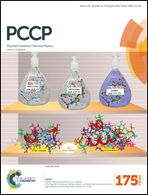Molecular dynamics simulation studies of hyperbranched polyglycerols and their encapsulation behaviors of small drug molecules†
Abstract
Hyperbranched polyglycerol (HPG) is one of the most important hyperbranched polymers (HBPs) due to its interesting properties and applications. Herein, the conformation of HPGs depending on the degree of polymerization (DP) and the degree of branching (DB) is investigated explicitly by molecular dynamics simulations. This study shows that the radius of gyration (Rg) scales as Rg ∼ DP1/3, which is in close agreement with the result of the SANS experiment. For HPGs with the same DP, the radius of gyration, asphericities and solvent accessible surface area all monotonically decrease with the increase of DB; while for HPGs with the same DB, the molecular anisotropy decreases with the increase of DP. The radial density investigation discloses that the cavities are randomly distributed in the interior of the HPG core to support the “dendritic box effect”, which can be used to encapsulate the guest molecules. Interestingly, the terminal groups of HPGs with a high Wiener index (WI) are more favorable to fold back into the interiors than those with the low WI when in water. For the hyperbranched multi-arm copolymer with a HPG core and many polyethylene glycol (PEG) arms, drug encapsulation studies show that the PEG caps can not only effectively prevent tamoxifen from leaving the HPG core, but also encapsulate tamoxifen inside the PEG chains. These simulation results have provided more details for understanding the structure–property relationships of HPGs in water.


 Please wait while we load your content...
Please wait while we load your content...